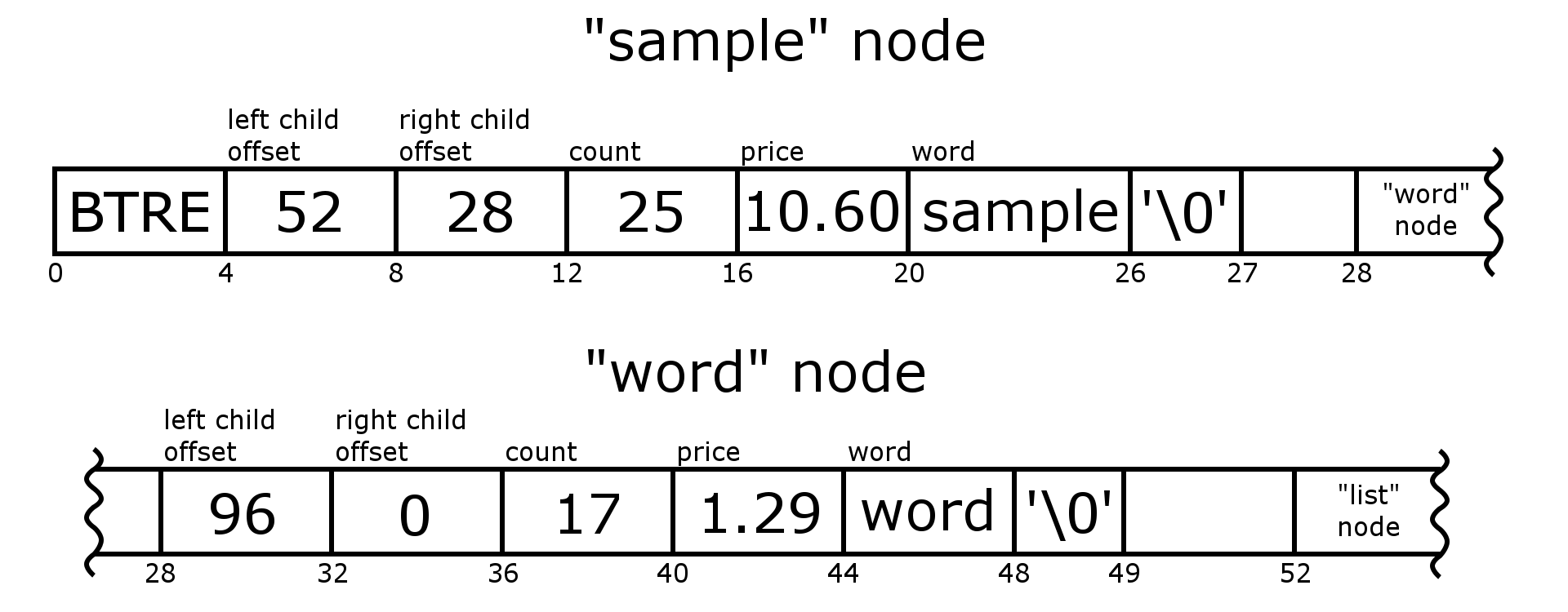Mad Mad Access Pattern
Mapping Inventory
You’ve landed an internship at Zing!, a search engine start-up. Your first project is to develop a keyword advertisement inventory tool.
Advertisers can “buy” keywords such that their ad is shown whenever a user does a search that contains one of their keywords. For example, if a user searches for “stapler”, they will see ads for an office supply company who bought that keyword.
Before buying a keyword, advertisers want to know, “How much will this cost me?” To compute that, they’ll need to know how often the keyword is searched for, and how valuable the word is. For example “how” is a very common word but has little value. “Donate” is less common but highly valuable, because a user searching for “donate” is probably willing to do so.
The intern before you scanned through a large volume of search logs to determine the frequency and value of each word. Your job is to perform efficient searches on the data file she created. This file is expected to grow to be very large, larger than will fit in memory, so you will need to access it without reading it all into memory.
Data File Structure
The file is structured like a binary search tree, where each tree node is an instance of this structure:
typedef struct {
uint32_t left_child; // offset of node containing left child
uint32_t right_child; // offset of node containing right child
// Offsets are relative to the beginning of the file.
// An offset of zero means the child does not exist.
uint32_t count; // number of times the word occurs in the data set
float price; // price of the word
char word[0]; // contents of the word, null-terminated
} BinaryTreeNode;The first 4 bytes of the input file are the letters “BTRE”. Any file which does not start with these 4 bytes is an invalid data file. The root node it stored at offset 4 in the file. Each uint32_t and float is stored in little-endian format (the same as the processors your VMs use, so no conversion will be necessary). “word” is an array of ASCII characters at the end of each structure, and it is a null-terminated string. There is no limit on the length of a word in the file or the length of the words your program will look up.
Remember the properties of a binary search tree: if a node has a left child, that child’s value is less than the node. If it has a right child, that child’s value is greater than the node. In other words:
BinaryTreeNode *node = ...a node from the file...
if (node->left_child) {
BinaryTreeNode *left = ...load node at node->left_child...
assert(strcmp(left->word, node->word) < 0);
}
if (node->right_child) {
BinaryTreeNode *right = ...load node at node->right_child...
assert(strcmp(right->word, node->word) > 0);
}
Files
You’ll be given:
- tree.h - contains the struct definition above and a detailed description of the data in sample.data
- Makefile - the makefile you should use to build lookup1 and lookup2
- lookup_reference - a reference implementation of lookup1
- sample.data - a small file containing the words “sample”, “word”, “list”, “for”, “this”, and “program”
- utils.h - Printing functions for you to use
- input_file - Sample input to create_file executable.
- create_file - Creates binary tree structured data file corresponding to input_file. This will be used for your test cases.
- print_file - Prints out human readable form of binary tree structured file from above.
Make two versions of your program. Both should produce the same results, but using different file access methods.
Version 1: fseek / fread
When reading a node from the file, use fseek() to jump to the correct posistion and read the node with fread() and/or fgetc(). You may not use mmap() for this part.
Put the code for this in lookup1.c.
Version 2: mmap
Use mmap() to map the entire file into memory without reading any part of the file directly. When reading a node from the memory mapped file, use pointer arithmetic to jump to the correct position and read the node using regular pointer dereferencing.
Put the code for this in lookup2.c.
Notice that you can use only mmap() to map the WHOLE file for this version. Do not use other functions to read files.
In both versions you should:
- Time your program:
- The timer should start before you open the file
- The timer should end after your close(version 1)/unmap(version 2) the file.
- Output the duration of your time with printTime()
- Use only the printing function we give you in utils.h
Sample usage
lookup1 <data_file> <keyword> [<keyword> ...]
lookup2 <data_file> <keyword> [<keyword> ...]
% ./lookup1 sample.data list sample werd
list: 12 at $0.04
sample: 25 at $10.60
werd not found
Execution time:0.000146 seconds
% ./lookup2 sample.data list sample werd
list: 12 at $0.04
sample: 25 at $10.60
werd not found
Execution time:0.000026 secondsTesting notes:
- Write your test cases to include comparison of performance between two versions- lookup1 and lookup2. Think about which one is faster and why?
- In order to generate different binary tree structured data files based on input required for each test case, use create_data executable. See input_file for sample input to this executable.
- print_file executable will provide the human readable form of binary tree structured data file generated from create_data executable.
Error cases:
- If run with less than 2 arguments, your program should print an error message describing the arguments it expects and exit with error code 1.
- If the data file cannot be read or the first 4 bytes are not “BTRE”, print a helpful error message and exit with error code 2.
For each word that is found, print its count and its price, where the price is always printed with exactly two digits to the right of the decimal point.